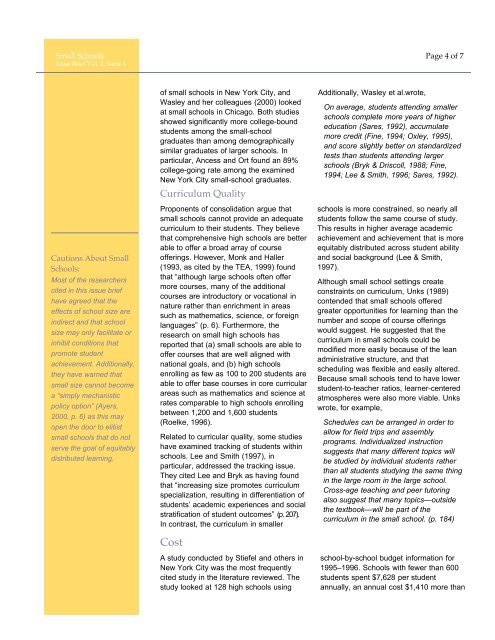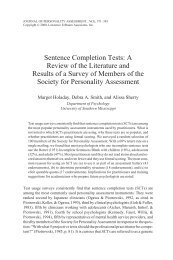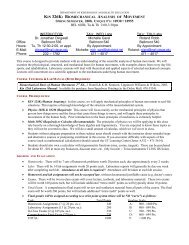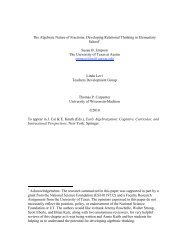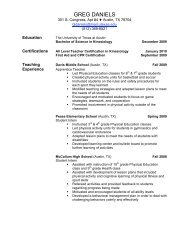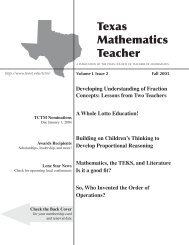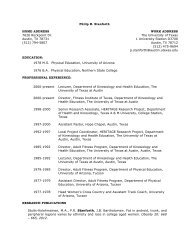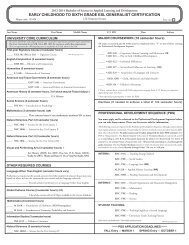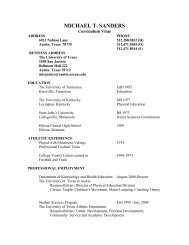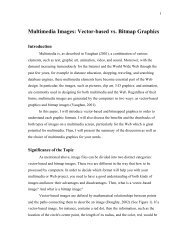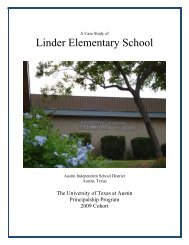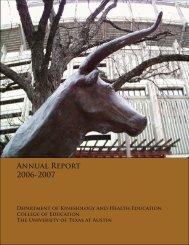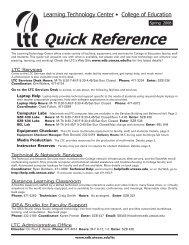High Schools: Size Does Matter - The College of Education - The ...
High Schools: Size Does Matter - The College of Education - The ...
High Schools: Size Does Matter - The College of Education - The ...
Create successful ePaper yourself
Turn your PDF publications into a flip-book with our unique Google optimized e-Paper software.
Small <strong>Schools</strong> Page 4 <strong>of</strong> 7<br />
Issue Brief Vol. 1, Issue 1<br />
Cautions About Small<br />
<strong>Schools</strong>:<br />
Most <strong>of</strong> the researchers<br />
cited in this issue brief<br />
have agreed that the<br />
effects <strong>of</strong> school size are<br />
indirect and that school<br />
size may only facilitate or<br />
inhibit conditions that<br />
promote student<br />
achievement. Additionally,<br />
they have warned that<br />
small size cannot become<br />
a “simply mechanistic<br />
policy option” (Ayers,<br />
2000, p. 6) as this may<br />
open the door to elitist<br />
small schools that do not<br />
serve the goal <strong>of</strong> equitably<br />
distributed learning.<br />
<strong>of</strong> small schools in New York City, and<br />
Wasley and her colleagues (2000) looked<br />
at small schools in Chicago. Both studies<br />
showed significantly more college-bound<br />
students among the small-school<br />
graduates than among demographically<br />
similar graduates <strong>of</strong> larger schools. In<br />
particular, Ancess and Ort found an 89%<br />
college-going rate among the examined<br />
New York City small-school graduates.<br />
Curriculum Quality<br />
Proponents <strong>of</strong> consolidation argue that<br />
small schools cannot provide an adequate<br />
curriculum to their students. <strong>The</strong>y believe<br />
that comprehensive high schools are better<br />
able to <strong>of</strong>fer a broad array <strong>of</strong> course<br />
<strong>of</strong>ferings. However, Monk and Haller<br />
(1993, as cited by the TEA, 1999) found<br />
that “although large schools <strong>of</strong>ten <strong>of</strong>fer<br />
more courses, many <strong>of</strong> the additional<br />
courses are introductory or vocational in<br />
nature rather than enrichment in areas<br />
such as mathematics, science, or foreign<br />
languages” (p. 6). Furthermore, the<br />
research on small high schools has<br />
reported that (a) small schools are able to<br />
<strong>of</strong>fer courses that are well aligned with<br />
national goals, and (b) high schools<br />
enrolling as few as 100 to 200 students are<br />
able to <strong>of</strong>fer base courses in core curricular<br />
areas such as mathematics and science at<br />
rates comparable to high schools enrolling<br />
between 1,200 and 1,600 students<br />
(Roelke, 1996).<br />
Related to curricular quality, some studies<br />
have examined tracking <strong>of</strong> students within<br />
schools. Lee and Smith (1997), in<br />
particular, addressed the tracking issue.<br />
<strong>The</strong>y cited Lee and Bryk as having found<br />
that “increasing size promotes curriculum<br />
specialization, resulting in differentiation <strong>of</strong><br />
students’ academic experiences and social<br />
stratification <strong>of</strong> student outcomes” (p. 207).<br />
In contrast, the curriculum in smaller<br />
Cost<br />
A study conducted by Stiefel and others in<br />
New York City was the most frequently<br />
cited study in the literature reviewed. <strong>The</strong><br />
study looked at 128 high schools using<br />
Additionally, Wasley et al.wrote,<br />
On average, students attending smaller<br />
schools complete more years <strong>of</strong> higher<br />
education (Sares, 1992), accumulate<br />
more credit (Fine, 1994; Oxley, 1995),<br />
and score slightly better on standardized<br />
tests than students attending larger<br />
schools (Bryk & Driscoll, 1988; Fine,<br />
1994; Lee & Smith, 1996; Sares, 1992).<br />
schools is more constrained, so nearly all<br />
students follow the same course <strong>of</strong> study.<br />
This results in higher average academic<br />
achievement and achievement that is more<br />
equitably distributed across student ability<br />
and social background (Lee & Smith,<br />
1997).<br />
Although small school settings create<br />
constraints on curriculum, Unks (1989)<br />
contended that small schools <strong>of</strong>fered<br />
greater opportunities for learning than the<br />
number and scope <strong>of</strong> course <strong>of</strong>ferings<br />
would suggest. He suggested that the<br />
curriculum in small schools could be<br />
modified more easily because <strong>of</strong> the lean<br />
administrative structure, and that<br />
scheduling was flexible and easily altered.<br />
Because small schools tend to have lower<br />
student-to-teacher ratios, learner-centered<br />
atmospheres were also more viable. Unks<br />
wrote, for example,<br />
Schedules can be arranged in order to<br />
allow for field trips and assembly<br />
programs. Individualized instruction<br />
suggests that many different topics will<br />
be studied by individual students rather<br />
than all students studying the same thing<br />
in the large room in the large school.<br />
Cross-age teaching and peer tutoring<br />
also suggest that many topics—outside<br />
the textbook—will be part <strong>of</strong> the<br />
curriculum in the small school. (p. 184)<br />
school-by-school budget information for<br />
1995–1996. <strong>Schools</strong> with fewer than 600<br />
students spent $7,628 per student<br />
annually, an annual cost $1,410 more than


